Review: 2013 Ford Fusion Hybrid (Video)

Want a fuel-sipping, tree-hugging sedan with stunning good looks? Ford thinks they have the answer in the 2013 Ford Fusion Hybrid. Can jamming a gasoline/electric drivetrain behind Ford’s sexy grille continue the love affair the press has had with Ford’s world-car? More importantly, can this Ford hybrid live up to its EPA numbers? Let’s find out.
Exterior
The new Fusion is as striking as the old one was bland. Up front we have an Aston-Martin inspired grille, angry headlamps and a tastefully reserved quantity of chrome. Out back we have a less daring rear end that some of my friends thought looked “unfinished” as if Ford just cut the sausage to the desired length. The stubby tail makes parallel parking a bit easier since it’s easy to know where your Fusion ends but I suspect rear-end repairs will be more costly than sedans with a more traditional bumper protrusion. The aggressive looks from the Optima and Fusion are refreshing in a segment full of humdrum slab sides and unrestrained chrome bling. I find the new Accord elegant in a 1990s Lexus sort of way, but the large green house screams family sedan. Toyota seems to have mated an edgy nose with refrigerator flat door panels to create a Camry that’s far from ugly but also far from sexy. Meanwhile VW’s Passat TDI strikes a very conservative pose with a large horizontal grille and segment-standard slab sides.
Interior
The new Fusion’s cabin has a level of refinement normally associated with European brands, and that makes sense since our Fusion is their Mondeo. The fit and finish in our tester was excellent with perfect seams and substantial feeling controls. While the new tiller doesn’t get soft split-grain leather like the new Accord, Ford’s new button arrangements are easier to use, easier to reach and feel better built than the wheel in the C-MAX and Escape. Like other Fusion models, most Hybrids sitting on the lot will look as if they were carved out of a single piece of black plastic. Selecting the tan cloth or the [seemingly] rare tan leather interior helps the interior feel warmer but there’s no way to avoid the large expanse of black that is the dashboard, carpet and large portion of the doors. If you love tan, keep in mind the Titanium comes only in black.
Front seat comfort is excellent although a step behind the Honda Accord which has the most comfortable seats in the segment. The Camry’s thrones are more “American-sized” but they aren’t as bolstered as those in the Fusion. Since seat preferences are as unique as people, spend some time behind the wheel before you buy. Unlike some of the competition, Ford’s tilt/telescoping steering wheel provides a large range of motion making it easy to accommodate drivers of different heights. Hybrid Fusions get standard10-way powered seats with an optional three-position memory system (standard on Titanium). As you would expect, the passenger doesn’t get the same kind of seat-love with your choice of manual or 4-way power adjusting.
Rear seats are as low to the ground as any in this segment, and far less bolstered than those in the front. Thanks to the sexy side-profile getting in and out of the rear seat required ducking more than in the competition and it cuts down on head room. If you find yourself needing to carry passengers in the rear that are over 6’1”, get the Camry, Passat or wait for the Accord. As always, I recommend you take your whole family with you shopping, stuff them all in the car and see how comfortable everyone is. Want to know more about the seating and cargo room? Check out the video review.
In an effort to increase useable cargo capacity (and improve mileage) Ford shifted from nickel based batteries to trendy and energy dense lithium-ion cells. The battery now sits on the floor of the trunk behind the rear seats and thanks to its reduced size, the rear seats are able to fold, something not possible with last year’s model. The folding rear seats are a novelty in this phone-booth sized segment with the Optima and Sonata ditching theirs entirely and the Camry offering a letter-box sized ski pass-through behind the passenger seat preventing long items from being inserted. When it comes to final capacity the Fusion lands in the middle with 12-cubes of cargo room compared to the Camry’s 13.1 and the Korean’s 9.9. If you click on the gallery at the bottom of this review you’ll see that the Fusion’s trunk is shaped so that it is possible to put roller bags on top of the battery making the trunk a bit more useful than the slightly larger Camry’s cargo hold.
Infotainment & Gadgets
All SE models start with a basic radio featuring six speakers, USB/iDevice control, XM Satellite Radio, Bluetooth phone integration and SYNC voice commands. If you don’t want your Fusion to be possessed by Ford’s touchscreen daemons, this is your only choice but at least it is an easy one to live with. Even the base SE model comes with power windows and door locks, a perimeter alarm, power driver’s seat, auto headlamps, body-colored mirrors and the keyless entry keypad that’s been a Ford hallmark for ages.
Most shoppers will need to get used to Ford’s temperamental touchscreen. If you want to check pretty much any option box on the Fusion, MFT either needs to be selected first or it is included in the bundle. Want dual-zone climate control, a backup cam, blind spot monitoring, auto headlights, rain-sensing wipers, a 120V outlet, cross traffic alert, etc? Better like MFT as well.
The $895 MFT option (standard on Titanium) consists of an 8-inch LCD in the dash, twin 4.2-inch LCDs in the gauge cluster, improved voice commands which now include climate control and touch-sensitive buttons for your HVAC system. Also bundled with the system is a backup camera and a 110V outlet in the center console. Thankfully, the latest version of Ford’s software seems to have resolved the frequent software crashes that plagues the system when it launched but the responsiveness issues persist. Perhaps worse for Ford than the slow graphics is that the competition has caught up and now offers similar levels of voice control and media device integration. MFT may still be one of the best looking systems on the market and it does bring a partial LCD dash to the party, but with viable options from the competition it has lost some of its shine.
While I’m not the biggest fan of Ford’s touch controls, they did prove more dependable than Cadillac’s new touch button setup and we noticed none of the fine scratched I have noticed on the Accord and Camry’s infotainment controls. If you want the best in factory entertainment, you should know the 12-speaker Sony branded audio system is only available in the more expensive Titanium.
The SE and Titanium trims can both be had with an impressive list of options from an automated-parking system to adaptive cruise control and an innovative lane departure prevention system. Unlike most of the LDP systems up to this point, the Ford system doesn’t apply the brakes to one side of the car to get you back on track – it simply turns the steering wheel. The system is both slightly creepy and very effective. With the ability to apply more force to keep you in the lane than competing systems, the steering input feels more like a hand on the wheel than a gentle suggestion. If safety is your shtick, it’s worth noting that the Fusion and Accord scored well in the new IIHS small-overlap test while the top-selling Camry tied with the Prius V for the worst of the group according to the IIHS.
Drivetrain
Under the hood you’ll find Ford’s completely redesigned hybrid system with a downsized 2.0L Atkinson cycle four-cylinder engine good for 141HP and 129lb-ft of twist. This is down slightly from the old 155HP 2.5L engine but Ford makes up for that with the hefty 118HP motor/generator inside their all-new HF34 hybrid transaxle. The combined system is good for 188HP and a TTAC estimated 200-220lb-ft of torque.
Rather than offering different hybrid systems for different vehicles like Toyota does, Ford uses the same system across their line up from the C-MAX to the Lincoln MKZ. While the heart of the system may be the new engine, the soul is the new 1.4kWh battery which is not only smaller and more energy dense than the old nickel pack, it can charge and discharge more rapidly as well. This improved battery “bandwidth” coupled to the stronger motors in their in-house hybrid transaxle allow the new Fusion Hybrid to motor down the highway on electrons alone up to 62MPH. It’s also the reason Ford claims the Fusion gets 47MPG City, 47MPG Highway and 47MPG on the combined cycle.
Oh that fuel economy
Fuel economy is a tricky business because your driving style, topography and curb weight are huge factors. I would caution readers to never compare our numbers with other publications because the driving conditions and styles are different. Still, nobody seems to be getting the vaulted 47MPGs in the latest Ford hybrid vehicles, TTAC included. Over a week and 568 miles our Fusion averaged 41MPG in mixed driving and my mountain commute, about 5/10ths lower than the C-MAX Hybrid I had two months earlier. Despite the fact that both the C-MAX and the Fusion Hybrid weight about the same (3,600lbs), the C-MAX was never able to get more than 45MPG no matter what I did.
The Fusion on the other hand managed 49MPG on a 36 mile level drive in moderate traffic and 46MPG on a level highway at 68MPH. While I wouldn’t say the Fusion meets expectations when it comes to fuel economy, it is better than the Kia’s 35.6MPG on the same course and a hair better than the Camry’s 40.5MPG. While I’m disappointed Ford’s new hybrid system hasn’t lived up to its advertising, the Fusion Hybrid is still the most efficient mid-sized sedan and it beats Ford’s 1.6L Ecoboost model by 12.5MPG in my tests.
I’ve included the Passat TDI here because I know a large segment of our readers would complain if it was missing. Still, I have trouble believing that many gasoline/electric hybrid shoppers would seriously cross shop the TDI. Should they? That depends. When we last had the Passat TDI we averaged 37MPG in mixed driving, 44 on the highway and around 29 in the city. If you commute in traffic, most of the hybrid options would deliver better mileage. Another thing to keep in mind is the cost of diesel in America, out here on the left-coast the cheapest diesel around according to GasBuddy.com was $4.09, a $0.25 premium over regular unleaded. This translated into $400 more in fuel costs per year over the MPGs we averaged in the Fusion Hybrid.
Drive
Despite having a decidedly American-sized 112.2-inch wheelbase, it’s obvious Ford’s European division took the lead when it came to the chassis. The result is a ride that is incredibly composed, tight in the corners and as communicative as anything with electric power steering. The surprises continue when you shift your right foot over to find linear brake feel, absolutely no Taurus-like brake fade and short stopping distances. Of course this is the hybrid model so there is still a transition point where the car adds friction braking in addition to the regenerative braking as you stop so things aren’t as smooth as with the “regular” Fusion. However, Ford’s new HF35 hybrid transaxle is quite simply the smoothest hybrid system this side of the Lexus LS 600hL easily besting the Camry and Lexus ES 300h in terms of hybrid system polish.
The Fusion provides, hands down, the best driving experience in this segment. Our tester ran to 60 in 7.31 seconds, only a hair behind the Camry, 1 second faster than the Optima and 2 seconds ahead of the Passat TDI, but it’s not straight line performance that I’m talking about. Thanks to wide 225-width rubber the Fusion is the first hybrid sedan I can describe as “fun” on mountain roads. I wouldn’t call it a corner carver, but it doesn’t immediately head for the bushes like an out of control land-yacht either. Sadly my theory for why the Fusion fails to live up to its 47MPG highway ratings is inexorably linked to its fun quotient. The larger your contact patch with the road, the more resistance you get and the lower your fuel economy will be. Still, looks sell (just ask Victoria’s Secret) and the Fusion’s combination of dashing good looks, excellent (but well below claimed) fuel economy and the best hybrid driving dynamics the Fusion is quite simply the best fuel-sipping mid-sized sedan for 2013.
Hit it
- Best pre-collision system in the segment, if you can afford it.
- Sportiest hybrid sedan on the market.
- Aston Martin’s mini-me.
Quit it
- Rear seats are cramped for adult passengers.
- Fuel economy doesn’t live up to the lofty claims unless you’re driving 55 on a flat highway.
- MyFord Touch now has some serious competition.
Ford provided the vehicle, one tank of gas and insurance for this review
0-30: 3.15 Seconds
0-60: 7.31 Seconds
1/4 Mile: 15.86 Seconds @ 90.4 MPH
Average Fuel Economy:41MPG over 568 Miles

More by Alex L. Dykes
Latest Car Reviews
Read moreLatest Product Reviews
Read moreRecent Comments
- SPPPP I am actually a pretty big Alfa fan ... and that is why I hate this car.
- SCE to AUX They're spending billions on this venture, so I hope so.Investing during a lull in the EV market seems like a smart move - "buy low, sell high" and all that.Key for Honda will be achieving high efficiency in its EVs, something not everybody can do.
- ChristianWimmer It might be overpriced for most, but probably not for the affluent city-dwellers who these are targeted at - we have tons of them in Munich where I live so I “get it”. I just think these look so terribly cheap and weird from a design POV.
- NotMyCircusNotMyMonkeys so many people here fellating musks fat sack, or hodling the baggies for TSLA. which are you?
- Kwik_Shift_Pro4X Canadians are able to win?



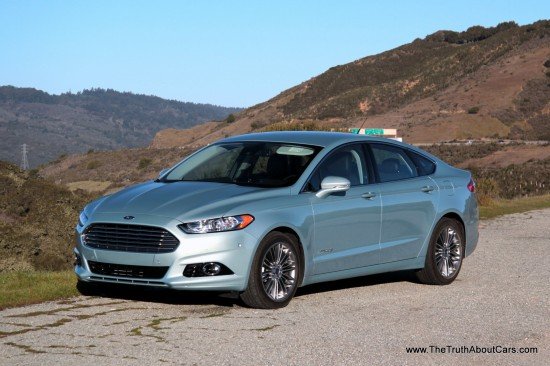




















































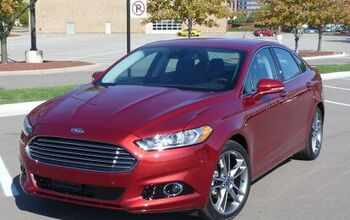
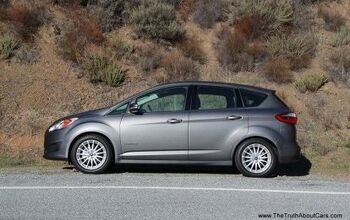
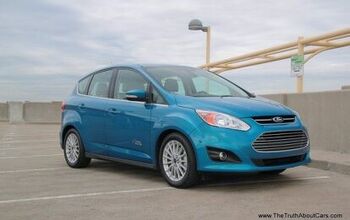
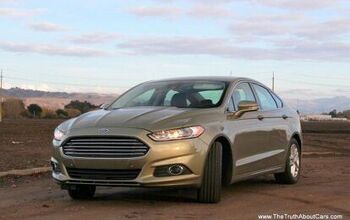










Comments
Join the conversation
I'm 6'3 and just took a cab version of one these from the airport. How the hell are you saying that the rear seat room is cramped? My first thought was damn this is roomy compared to the previous crop of "midsizers". Cars keep getting bigger yet reviewers keep on with the same old gripes. Weak way to throw in some criticism for "balance".
Hi, I am one of the consumer lawyers at Girard Gibbs LLP. We recently filed a lawsuit on behalf of New Mexico, New Hampshire and California owners and lessees alleging that the fuel economy of the 2013 Ford Fusion Hybrid and C-MAX Hybrid is approximately 10 MPG lower than the 47 MPG advertised by Ford. If you are interested in sharing your experience with us, feel free to email (ctc@girardgibbs.com) or call (866-981-4800). Tucker Cottingham